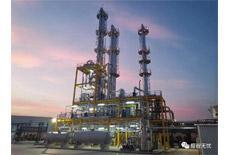As an Ethyl Acetate Plant Supplier, share with you.

Ethyl Acetate Production Technology
1. The esterification reaction is a reversible reaction. In order to increase
the yield of esters, the reaction must be made as far as possible to facilitate the formation of esters. Generally, one of the reactants acid and alcohol is made in excess. In industrial production, which kind of excess is better,
generally depends on whether the raw materials are easily available, whether the
price is cheap, and whether it is easy to recycle and other specific circumstances. In the laboratory, the method of excessive ethanol is generally
used. The mass fraction of ethanol should be high, and the effect would be
better if the ethanol with a mass fraction of 95% could be replaced by anhydrous
ethanol. The amount of concentrated sulfuric acid used in the catalysis is very
small. Generally, the catalysis can be completed as long as the quality of
sulfuric acid reaches 3% of the mass of ethanol. However, in order to remove the
water generated in the reaction, the amount of concentrated sulfuric acid should
be increased slightly.
2. When preparing ethyl acetate, the reaction temperature should not be too
high. Keep it between 60℃ and 70℃. When the temperature is too high, impurities
such as ether, sulfurous acid or ethylene will be produced. After the liquid is heated to boiling, it should be heated with a small fire. Several pieces of
broken porcelain can be added to the test tube in advance to prevent the liquid
from bumping.
3. Do not extend the air duct into the Na2CO3 solution to prevent the Na2CO3
solution from being poured into the test tube of the heated reactant due to
uneven heating. In addition, ethanol and acetic acid are easily soluble in water, which can cause back suction.
4. Concentrated sulfuric acid is used both as a catalyst and as a
water-absorbing agent.
5. The role of Na2CO3 solution is:
⑴The function of saturated sodium carbonate solution is to condense the ester
vapor, reduce the solubility of the ester in water (facilitate the layering),
remove the acetic acid mixed in ethyl acetate, and dissolve the ethanol mixed in
ethyl acetate.
⑵Na2CO3 can react with volatilized acetic acid to produce odorless sodium
acetate, which is convenient to smell the scent of ethyl acetate.
6. In order to facilitate the production of ethyl acetate, the following
measures can be taken:
⑴ When preparing ethyl acetate, the reaction temperature should not be too
high.
⑵It is best to use glacial acetic acid and absolute ethanol. At the same
time, an excess of ethanol is used.
⑶ The amount of concentrated sulfuric acid used for catalysis is very small,
but in order to remove the water generated in the reaction, the amount of
concentrated sulfuric acid is slightly more than that of ethanol.
⑷Use inorganic salt Na2CO3 solution to absorb the volatilized acetic
acid.
7. The reason why Na2CO3 can't use alkali (NaOH): Although it can also absorb
acetic acid and ethanol, the alkali will catalyze the complete hydrolysis of
ethyl acetate, causing the experiment to fail.
Our company also has Ethyl Acetate Production Technology on sale, welcome to
contact us.














